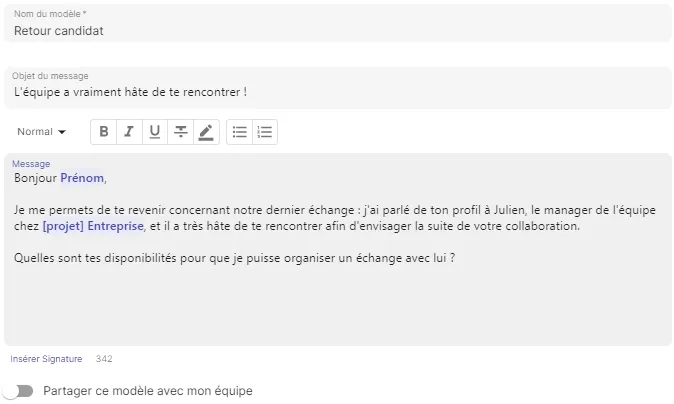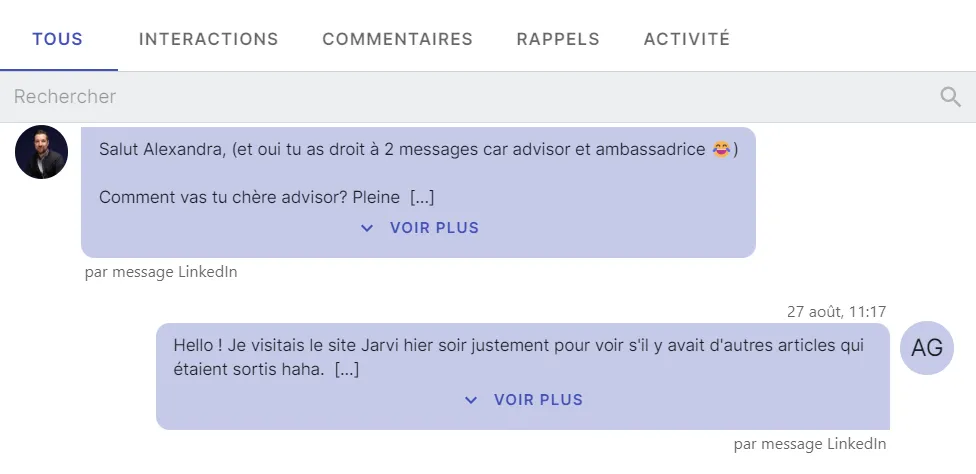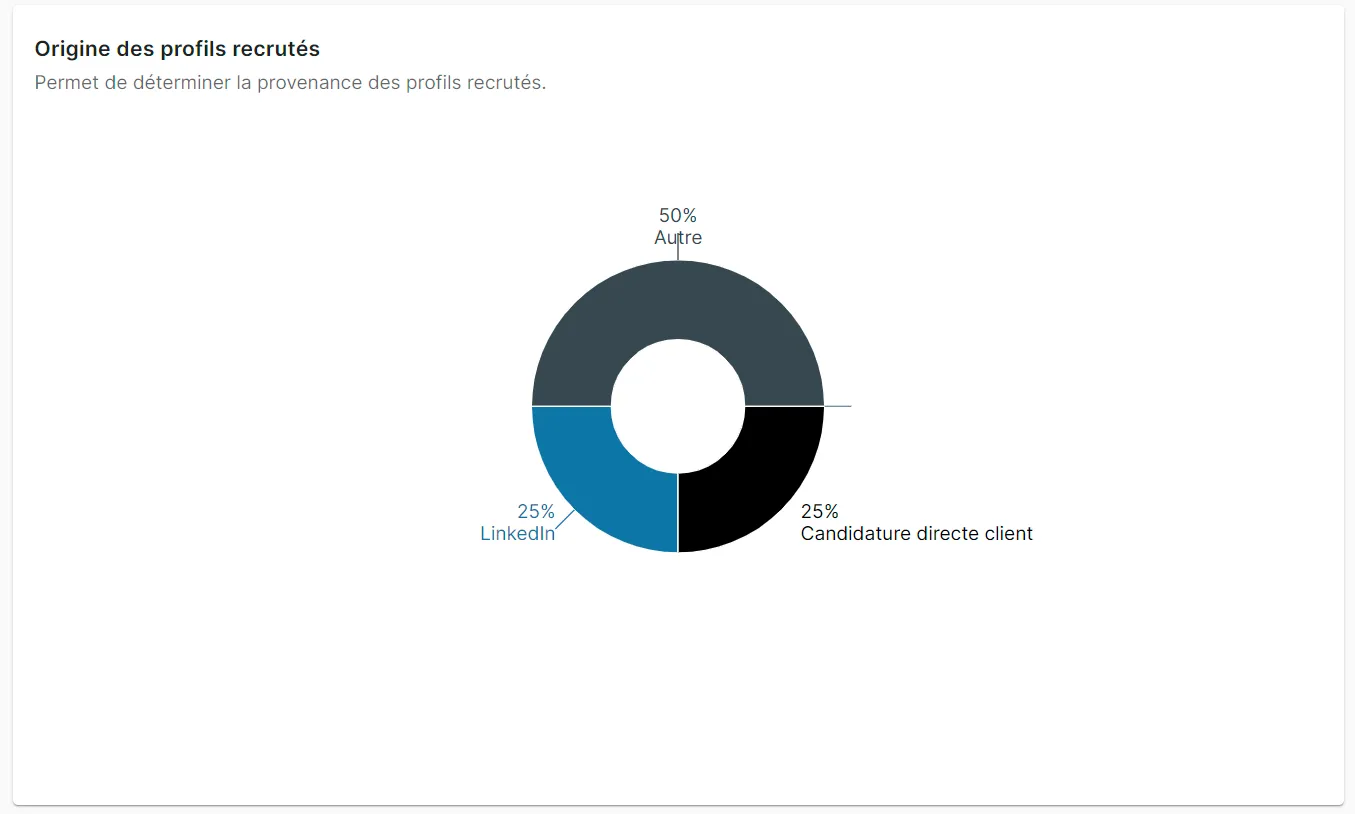Part 1: Definition and Strategies to Adopt.
Candidate experience has often been underestimated by companies and their recruiters. Often? It’s still frequently the case in many companies today. Yet, according to a study by TalentPlug, 52% of candidates turn down a job offer due to a poor candidate experience during the recruitment process.
In this article, I’ll aim to clarify things to help you see much more clearly!
What is Candidate Experience?
Let’s start with a simple definition: candidate experience encompasses all the interactions a candidate has throughout their recruitment process, from the first contact to their onboarding, or even after a rejection.
However, it’s crucial to clarify what we mean by “recruitment process,” as this concept can vary from person to person. For some, the process begins with the first exchange with the candidate and ends with the signing of the contract. For others, it extends to the start of the role, or even to the end of the probation period.
An often overlooked aspect is that candidate experience begins well before these formal stages. As soon as someone interacts with your brand—through your website, job postings, or even your social media content—they start forming an opinion of you as a potential employer.
This changes everything: candidate experience isn’t limited to direct interactions. It includes everything from the smoothness of the application process to the clarity of communications, the speed of feedback, and adherence to timelines.
Of course, respectful exchanges, personalized feedback, and good listening are essential. But if your application process is lengthy, poorly optimized, or lacks transparency, it can undermine all your efforts. Candidate experience is a continuous chain of interactions, and every link matters.
In practical terms, this experience covers the entire candidate journey, from their first contact with your brand to their final onboarding or, sometimes, to the point where they withdraw or are declined an opportunity. But even after a rejection, the experience continues through nurturing actions, which help maintain a connection for future opportunities.
How to Enhance the Candidate Experience
As you might have guessed, the candidate experience is more than just a simple interaction between a recruiter and a candidate. It’s built throughout the journey at various key moments. It’s a proactive approach that requires organization and the right tools to maximize each interaction.
Here are several actions to implement to optimize each stage of the process.
1. Before the Recruitment Process
- Develop and Communicate a Strong Employer Brand: Create an attractive and informative careers page. Highlight employee testimonials, unique videos about company culture, and information about the company’s values and mission. These elements help attract talent long before they become candidates.
- Enhance Social Media Presence: Share engaging and relevant content to showcase your internal dynamics and appeal as an employer. This can range from posting job openings to sharing real-life examples of company life, including an employee advocacy program, for instance.
- Provide Transparency About Roles: Publish precise and realistic job descriptions. Include employee testimonials to give a genuine and human image of the team, responsibilities, and growth opportunities.
- Simplify Access to Job Listings: Ensure smooth and intuitive navigation on your careers page, especially on mobile. An optimized candidate journey also means easy-to-find and easy-to-apply job listings.
- Offer an Assistance Chatbot: A chatbot can answer common candidate questions and provide immediate help. If possible, opt for real-time chat managed by humans to offer more personalized responses.
2. When Applying
- Streamline the Application Process: Keep required fields to a minimum and allow LinkedIn profile integration to speed up the application. Candidates appreciate being able to apply with just a few clicks, without a cumbersome process.
- Enhance Mobile Experience: Your platform should be smooth and responsive on all devices, as many candidates apply via their smartphones. Simplicity and user-friendliness are key success factors.
- Inform About the Process: Once an application is submitted, clearly outline the next steps. How long before a response? What are the stages of the selection process? This reduces candidates’ anxiety and helps them manage their expectations.
- Send an Automatic Acknowledgment: As soon as a candidate applies, send a personalized email to confirm receipt of their application and inform them of the next steps. This shows you respect their time and interest in the company.

3. During Interviews
- Make a Good First Impression: A warm welcome, whether in person or virtually, is crucial. Provide a clear briefing before the interview: location, time, participants, and tools. Show the candidate they are expected and prepared for each interaction.
- Prepare Recruiters and Managers: Train your teams to conduct inclusive and unbiased interviews. Using structured interviews and scorecards ensures fairness in evaluating candidates.
- Inform Candidates: Give them information about the objectives of each interview, the expected duration, and the people they will meet. This helps the candidate be prepared and feel comfortable.
- Be Punctual and Respectful: Stick to the scheduled interview times and notify candidates in case of delays. Punctuality is a sign of respect and a good indicator of your company’s culture.
- Make Interviews Interactive: Encourage candidates to ask questions and learn about the company. An interview should not be one-sided but a mutual exchange of information.
- Provide Prompt Feedback: After each interview, offer constructive feedback, whether positive or negative. This shows you value the time the candidate has invested.
4. After the Interviews
- Transparent and Prompt Follow-up: Quickly communicate with candidates after the interview. If the process takes time, keep them informed to avoid any frustration. Nobody likes being left in the dark.
- Provide Detailed Feedback: Offer constructive feedback to candidates who weren’t selected. This helps them understand why their application wasn’t successful and gives them pointers for improvement in the future.
- Ensure a Final Response to All Candidates: Never leave a candidate without a response. Even if the decision is negative, the respect for their effort deserves a clear final communication.
- Create a Positive Experience Even in Rejection: Thank candidates for their interest and encourage them to apply again if another opportunity matches their profile. This leaves a positive impression of your company.
5. During the Trial Period (for Selected Candidates)
- Organize a Structured Onboarding: A quality onboarding prepares the new team member for their responsibilities. Offer a training plan, set goals, and introduce them to the teams so they feel integrated quickly.
- Provide Personalized Support: Assigning a mentor or buddy helps new hires adapt to their new work environment.
- Stay Attentive to the New Team Member: Regularly gather their feedback and adjust your processes if necessary. Personalized follow-up fosters engagement.
- Schedule Regular Check-ins: Set regular meetings to assess progress and adjust responsibilities according to the team member’s skills and aspirations.
- Share the Company’s Vision: Ensure the team member is well-acquainted with the company’s strategic goals and vision so they can align with them from the start.
6. For Rejected Candidates
- Provide Constructive Feedback: Offering detailed and personalized feedback on strengths and areas for improvement helps candidates progress in their future endeavors.
- Maintain a Relationship with Unselected Candidates: Include them in a talent pool, giving them the chance to participate in events or stay informed about future opportunities through newsletters. This is known as nurturing.
- Offer Post-Recruitment Follow-Up: For candidates who were rejected later in the process, offer follow-up or coaching sessions to help them guide their career.
- Request Feedback: Gather impressions from rejected candidates to understand how to improve your process.
- Encourage Reapplication: Show candidates that they are welcome to apply for other positions that might better suit their profile.
Ultimately, improving the candidate experience isn’t just about a few tweaks, but a comprehensive approach that touches every stage of the recruitment process.
However, as you can see, some actions are relatively easy to implement. Moreover, every interaction and moment is an opportunity to strengthen your employer brand and attract top talent.
Finally, you might not have noticed, but there’s plenty here to delegate to your teams, offering them a rewarding employee experience as well!
What are the benefits of a great candidate experience?
A question many companies ask: why invest in improving the candidate experience? Is it really necessary?
The answer is simple: yes, and there are numerous benefits to doing so. Enhancing the candidate experience isn’t just about making candidates happy. It directly impacts your brand, internal processes, and even the overall productivity of your company. Not to mention, it gives you a significant competitive edge.
Here are the main benefits:
- Improved company reputation: A positive candidate experience strengthens your employer brand and enhances how candidates perceive your company, naturally attracting more high-quality talent.
- Increase in qualified applications: Candidates who have a positive experience are more likely to recommend your company to other talents, thereby expanding your candidate pool.
- Reduced recruitment costs: A more efficient process shortens recruitment time and decreases turnover, reducing costs associated with hiring and training.
- Retention of non-selected candidates: A candidate who wasn’t selected but had a good experience is more likely to apply again or become an ambassador for your brand, increasing the chances of future collaborations.
- Enhanced engagement of new employees: A candidate who has had a positive experience throughout the hiring process is more engaged, motivated, and involved from the moment they join the company.
- Lower dropout rates: An excellent experience reduces the risk of candidates dropping out, as they feel valued and well-informed throughout the process.
- Time savings for recruiters: A well-designed recruitment process and clear communication allow recruiters to handle applications more efficiently and reduce administrative efforts.
- Better diversity management: An inclusive experience attracts diverse talents, contributing to a better company culture and improved performance.
- Strengthened overall brand image: Candidates, whether hired or not, share their experiences with their network. This can positively influence the company’s image not only among talents but also with clients and partners.
- Trust and transparency: Transparent processes build candidates’ trust in the company, enhancing their perception of the employer brand.
- Competitive differentiation: In an increasingly competitive market, an excellent candidate experience becomes a competitive advantage in attracting top talent against competitors.
- Reduced negative online reviews: Disappointed candidates may share their negative experiences on platforms like Glassdoor. A good experience reduces this risk and improves the company’s reputation.
- More accurate assessment of company culture: By interacting positively with the company throughout the process, candidates can better understand the company culture, allowing for alignment of expectations.

In summary, providing an optimized candidate experience benefits not just your candidates, but your entire organization. It’s a strategic investment that yields tangible and measurable returns in the long run.
Do we really need to say more?
In the next section, I’ll explain which KPIs you should implement to track the results of your efforts. Stay tuned!
Part 2: Which KPIs to Track?
In my previous article, I explained what candidate experience is, how long it lasts in your recruitment process, and most importantly, when it begins.
You’ve probably thought about how you could improve things in your process by conducting a thorough audit.
Now, I’ll explain how to measure your efforts with some interesting KPIs, and how Jarvi can become your most valuable partner in tracking these KPIs and, more importantly, in the success of your candidate experience.
KPIs to Track for Measuring Your Efforts

Now that you’ve implemented actions to improve the candidate experience, it’s crucial to measure their impact. How do you know if these efforts are paying off? With relevant KPIs that allow you to track and optimize each step of the recruitment process.
Here are the most important KPIs to monitor:
- Conversion Rate at Each Stage of the Process
The conversion rate measures the percentage of candidates who move from one stage of the process to another, for example, from application submission to interview. This indicator helps identify friction points where candidates drop out or are eliminated, allowing you to adjust your methods and improve the flow of the recruitment process.
- Candidate Satisfaction Rate (NPS - Net Promoter Score)
The candidate NPS evaluates the satisfaction of candidates at the end of the recruitment process, whether they are hired or not. Usually measured through a survey, this indicator is a direct reflection of the quality of the candidate experience. It helps identify areas for improvement in your management of candidate interactions.
- Average Response Time to Candidates
The average response time measures the time elapsed between receiving an application and sending the first response to the candidate. Responsiveness is crucial for providing a good experience, as long delays can frustrate candidates and push them to apply elsewhere. This indicator is essential for ensuring good time management.
- Average Time to Process an Application
The average processing time corresponds to the total duration between receiving an application and making the final decision (positive or negative). A process that takes too long can lead to a loss of interest from candidates and harm your company’s image. This is a key indicator for adjusting the length of your processes.
- Time to Hire
Time to hire is the total duration between the first interaction with a candidate and the acceptance of the job offer. It measures how quickly your company recruits after identifying a suitable candidate. An optimized time to hire means you minimize waiting times for talent and reduce the risk of losing quality candidates due to a slow process.
- Time to Fill
Time to fill measures the time needed to fill a vacant position from the moment the job is posted until a candidate accepts the position. This indicator helps you understand the overall speed of your recruitment process. A long time to fill may indicate a problem in your sourcing or selection processes.
- Candidate Dropout Rate
The dropout rate measures the percentage of candidates who voluntarily leave the recruitment process before its completion. A high dropout rate can signal issues related to process clarity, step length, or lack of communication. This indicator helps you adjust the journey to reduce these dropouts.
- Number of Spontaneous Applications
This KPI calculates the number of applications received without the company actively posting a job offer. It reflects the spontaneous attractiveness of your employer brand. The more spontaneous applications you receive, the more your company is perceived as an employer of choice, even without specific sourcing efforts.
- New Hire Satisfaction Rate After the Trial Period
This KPI measures the satisfaction of new employees at the end of their trial period regarding their recruitment experience. It allows you to verify if the expectations created during recruitment match the reality of the position, which is crucial for long-term talent retention.
- Cost per Hire
Cost per hire calculates the average expenses associated with each recruitment, including the costs of tools, human resources, and marketing. Optimizing this cost while maintaining a quality candidate experience is essential for ensuring the profitability of your recruitment process.
- New Hire Retention Rate
The retention rate measures the percentage of new employees who stay with the company after a given period, such as 6 months or 1 year. A high rate indicates a successful candidate experience and a good match between the candidate’s expectations and the reality of the position.
- Diversity Score of Recruited Candidates
This KPI measures the diversity of recruited profiles based on criteria such as gender, origin, or professional background. An inclusive candidate experience promotes diversity within your company and enhances the richness of your teams.
- Re-engagement Rate of Unsuccessful Candidates
The re-engagement rate corresponds to the percentage of unsuccessful candidates who reapply for other positions in your company. It shows that the rejection experience was positive enough for these candidates to consider returning, an excellent indicator of the quality of your post-recruitment relationship.
- Feedback Tool Usage Rate
This indicator measures how many candidates use the tools provided to give feedback on the recruitment process (surveys, evaluations). A high rate shows that candidates feel heard and that you take their feedback into account to continuously improve the experience.
- New Hire Recommendation Rate (eNPS - Employee Net Promoter Score)
The eNPS measures the likelihood that new hires will recommend the company to other candidates or friends. A good eNPS indicates that the onboarding was successful and that the candidate experience helped strengthen their engagement.
These KPIs provide an overview of what works and what can be improved in your recruitment process. By regularly tracking these indicators, you can refine your practices, enhance the candidate experience, and optimize your results. Remember: start with a few key indicators before expanding your tracking as you make adjustments.
How Does Jarvi Enhance Your Candidate Experience?
Curious about how Jarvi can practically help you improve your candidate experience?
Here are some features that make Jarvi a valuable partner in optimizing your recruitment process:
- Real-time KPI Tracking: Jarvi allows you to monitor indicators like candidate response rates, conversion rates at each stage, and time-to-hire. This enables you to adjust your process as needed and immediately identify where candidates are dropping off.

- Real-time Alerts for Candidate Messages: Jarvi notifies you as soon as a candidate sends a message, allowing you to respond quickly and avoid any oversights. This keeps you up-to-date, enhancing your responsiveness and the impression candidates have of your company.

- Customizable Communication Templates: You can create message templates for each key stage of the recruitment process. This helps automate and personalize communications while maintaining a high level of quality in your interactions with candidates.

- Comprehensive Interaction History: With Jarvi, you have access to the complete history of exchanges with each candidate, allowing you to personalize your messages and precisely track the status of each application.

- Recruitment Channel Analysis: Jarvi helps you identify where your top candidates are coming from (social media, job boards, referrals, etc.) and adjust your recruitment efforts accordingly.

- Nurturing Unsuccessful Candidates: Jarvi helps you stay in touch with candidates who weren’t selected through nurturing campaigns you can set up. For instance, you can send them information about future opportunities. This way, you can maintain a relationship with them, keep them informed about company developments, and encourage them to apply again later.
In conclusion, Jarvi provides you with the tools needed not only to enhance the quality of your recruitment process but also to optimize every step of the candidate journey. This allows you to offer an exceptional candidate experience and attract top talent.
To learn more, you can discover how to use Jarvi for candidate nurturing by reading this article: How to Use Jarvi for Nurturing.

